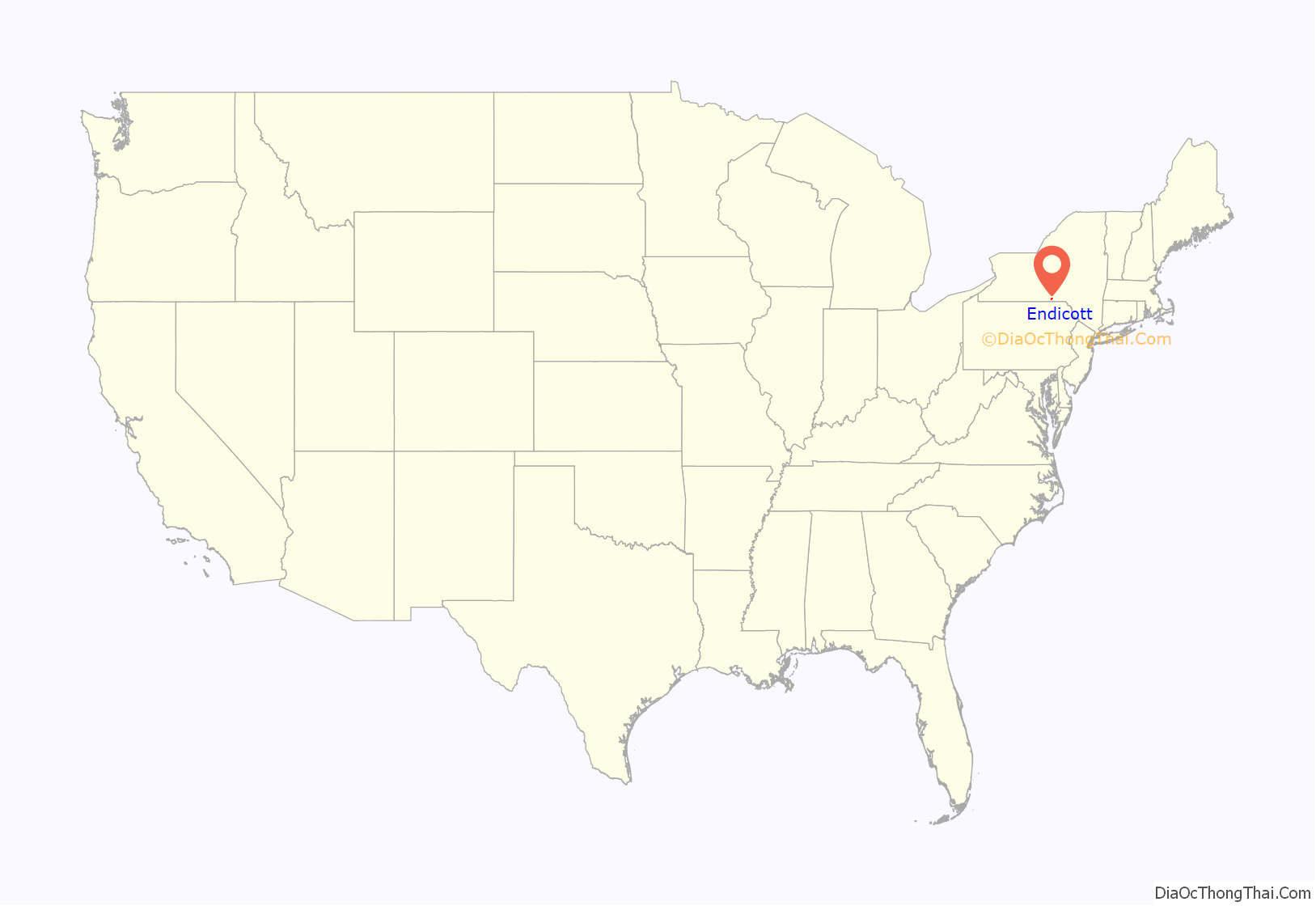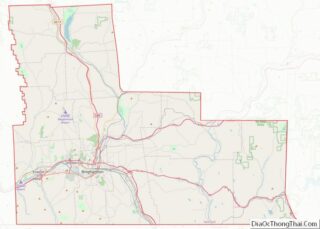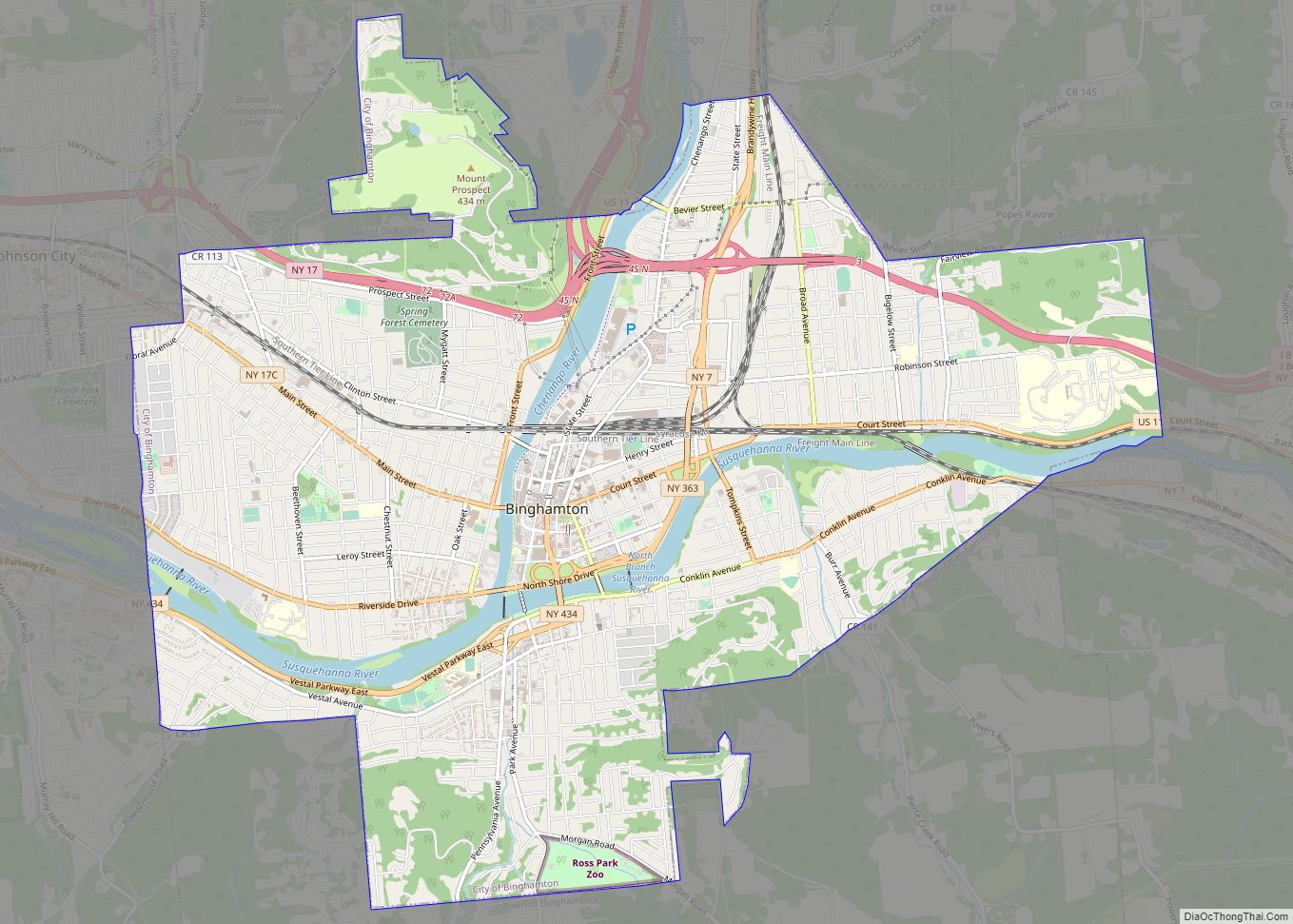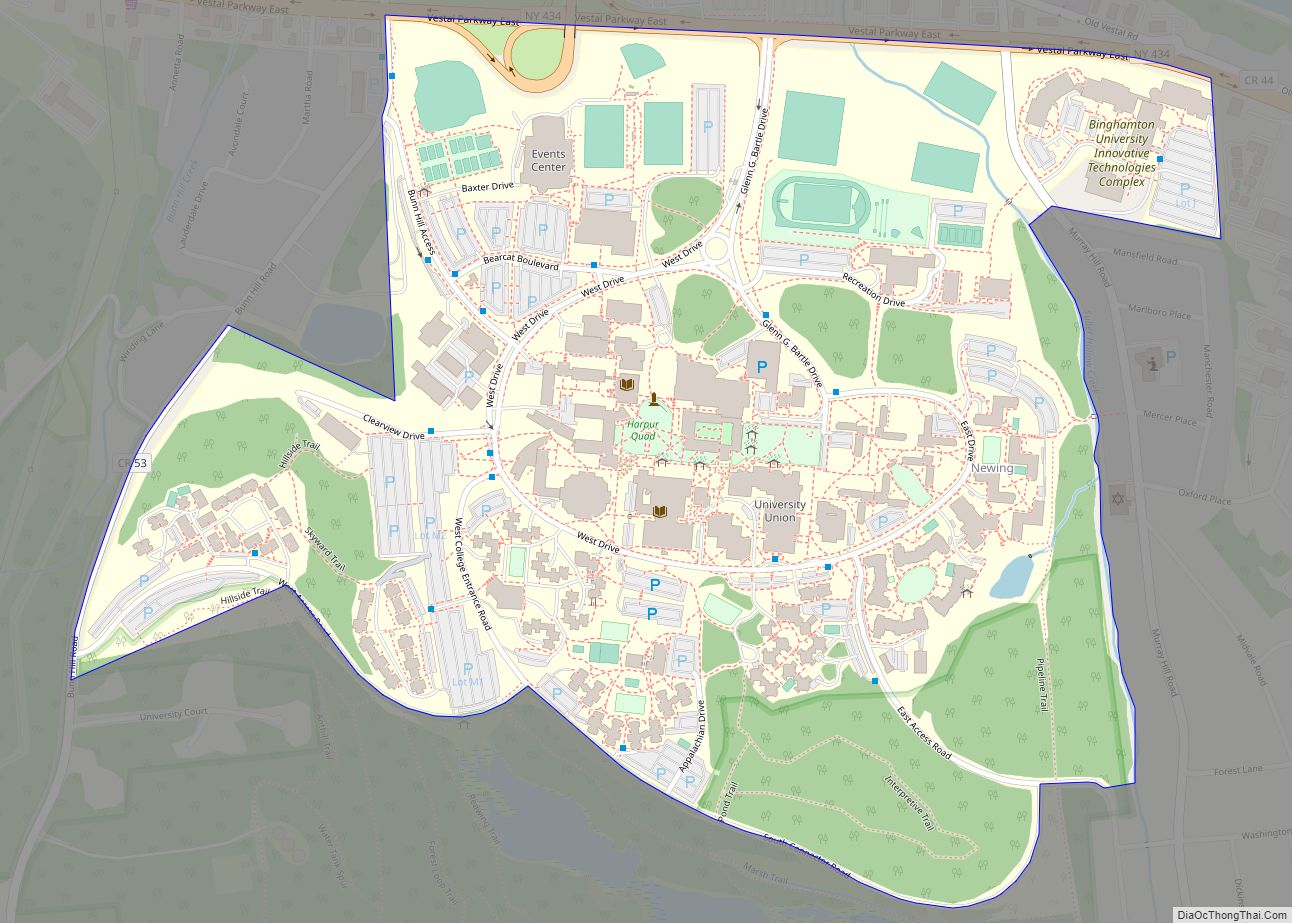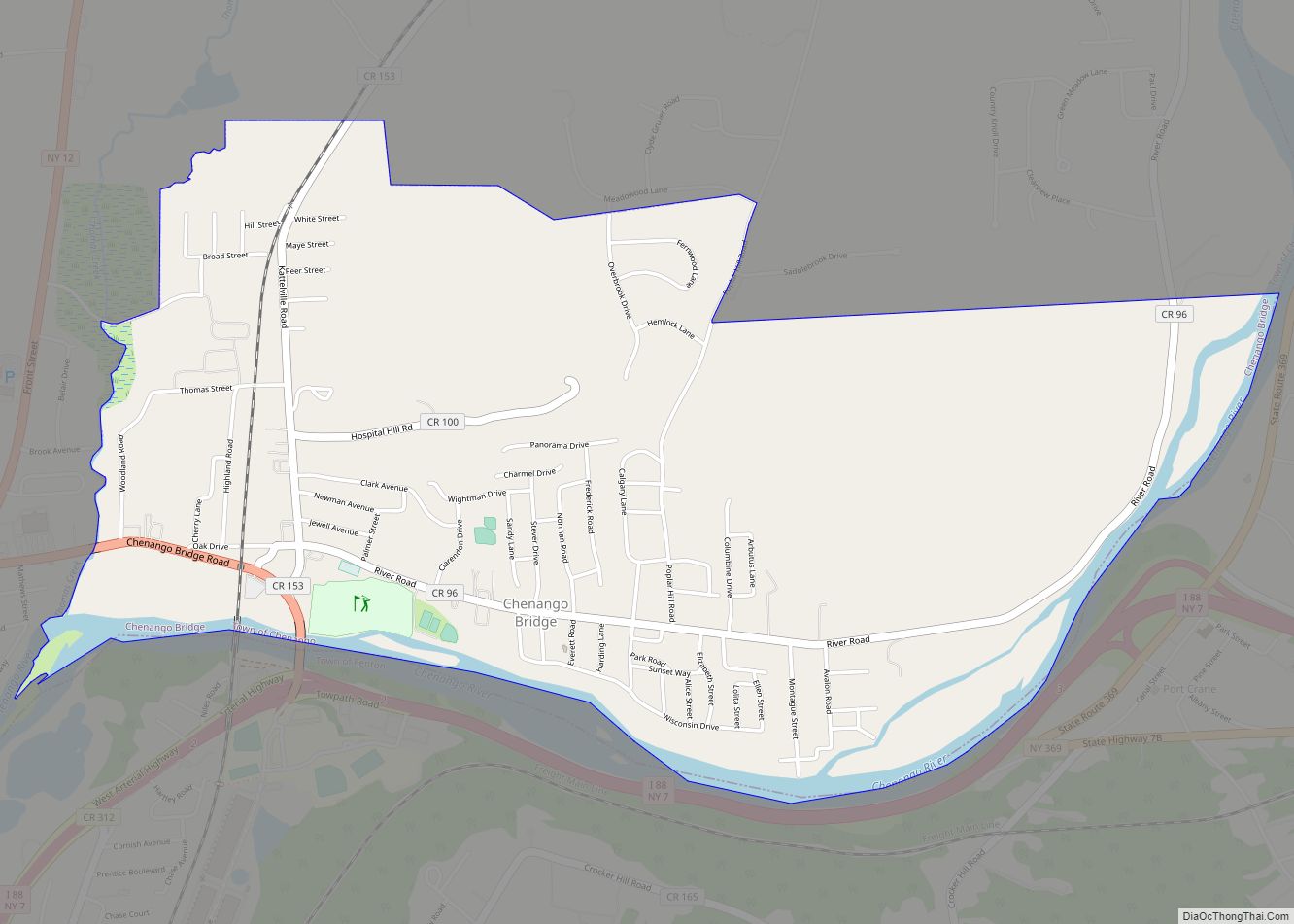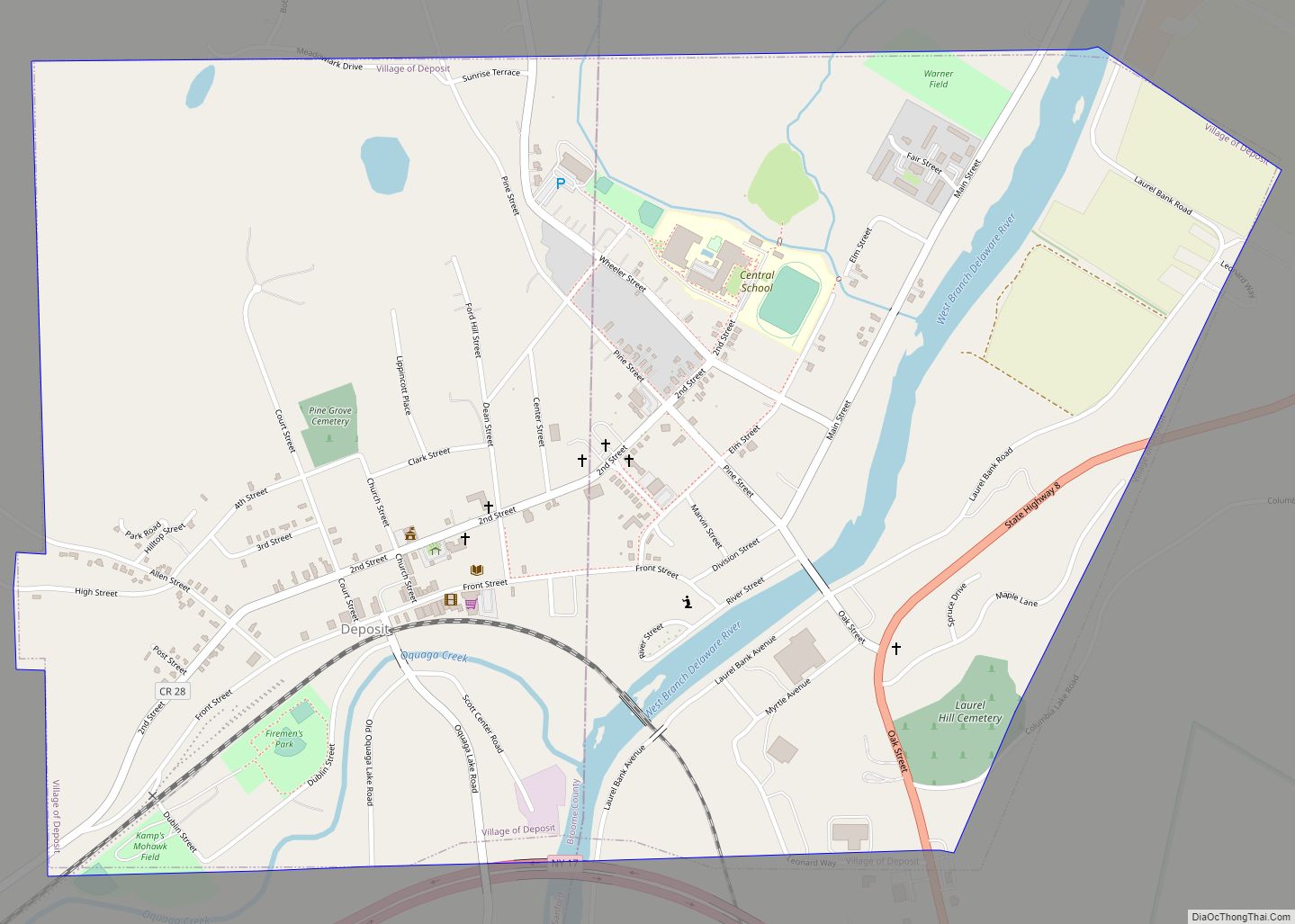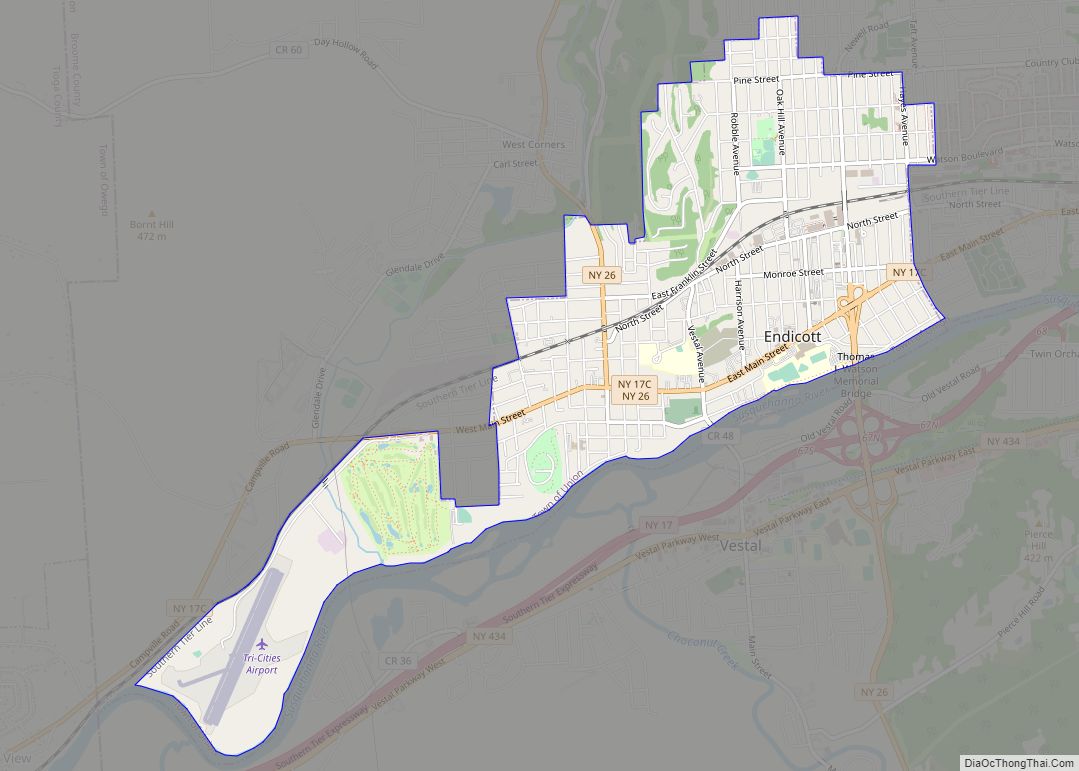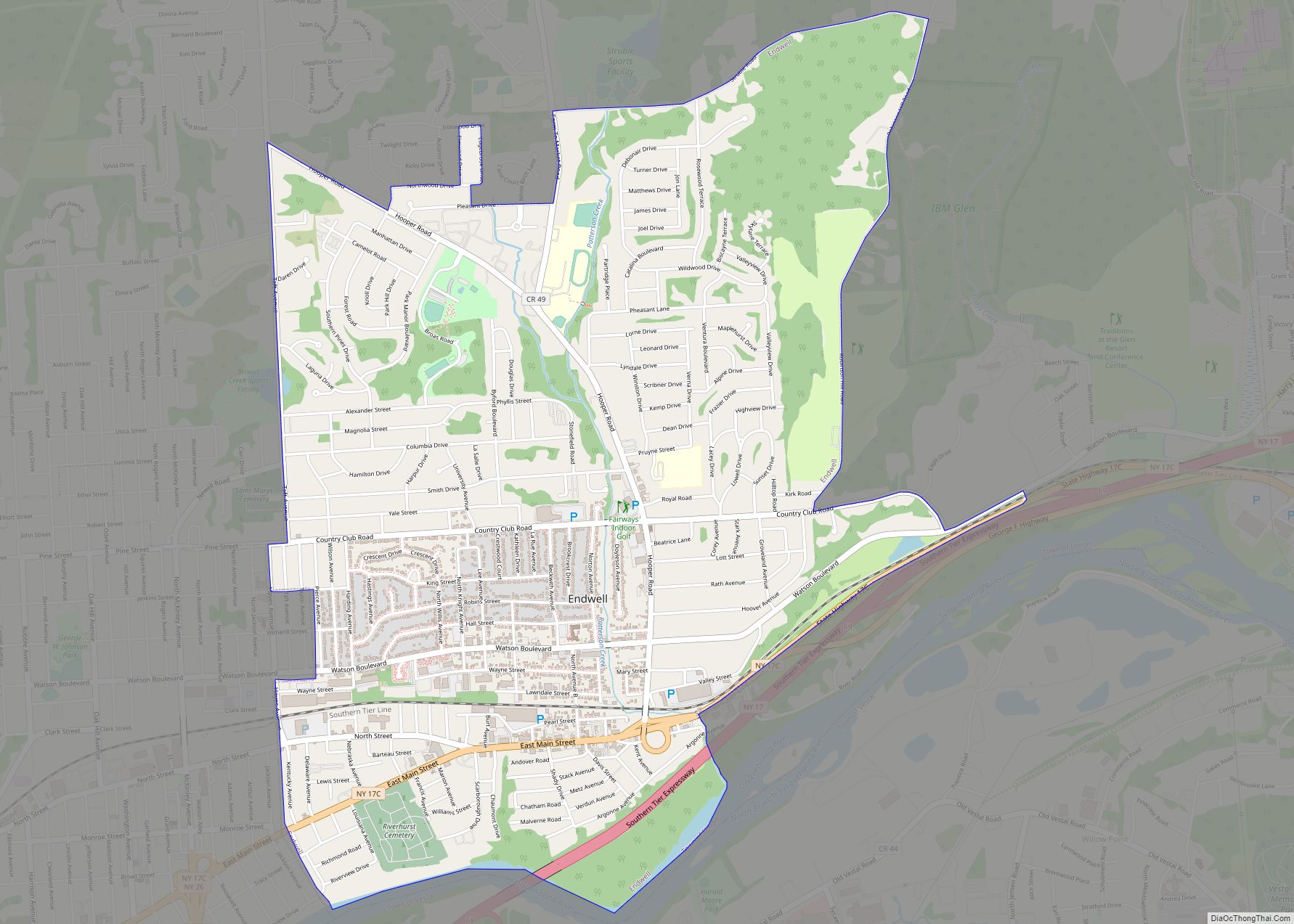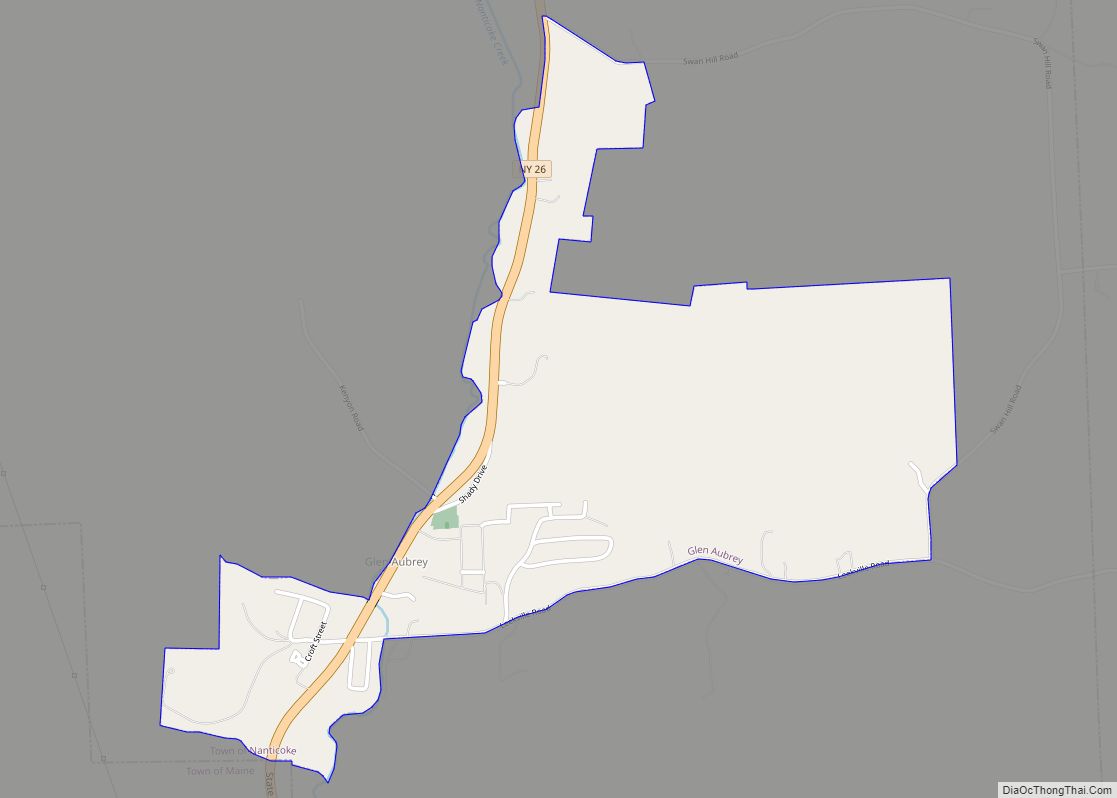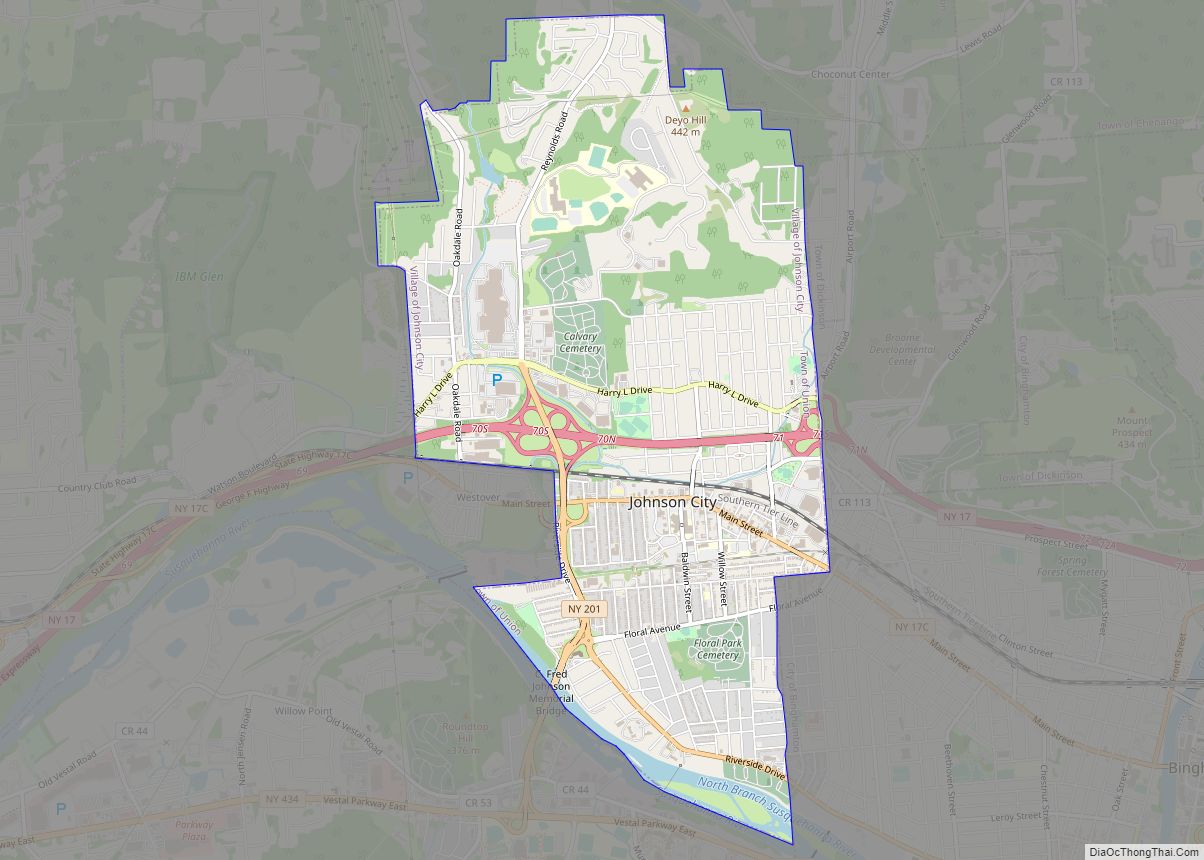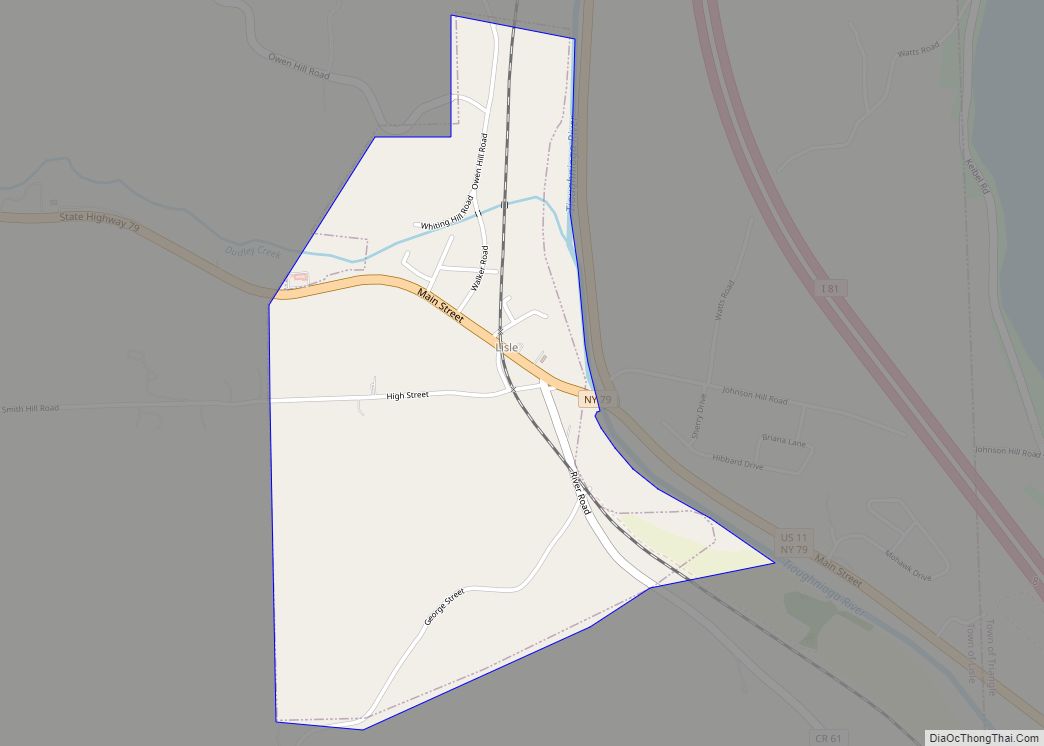Endicott is a village in Broome County, New York, United States. The population was 13,392 at the 2010 census. It is part of the Binghamton Metropolitan Statistical Area. The village is named after Henry B. Endicott, a founding member of the Endicott Johnson Corporation shoe manufacturing company, who founded the community as the “Home of the Square Deal”.
The village of Endicott is in the town of Union and is west of the city of Binghamton. The community is served by the Greater Binghamton Airport/Edwin A. Link Field. It is part of the “Triple Cities”, along with Binghamton and Johnson City.
| Name: | Endicott village |
|---|---|
| LSAD Code: | 47 |
| LSAD Description: | village (suffix) |
| State: | New York |
| County: | Broome County |
| Incorporated: | 1906; 117 years ago (1906) |
| Elevation: | 840 ft (256 m) |
| Total Area: | 3.20 sq mi (8.28 km²) |
| Land Area: | 3.19 sq mi (8.27 km²) |
| Water Area: | 0.00 sq mi (0.01 km²) |
| Total Population: | 13,667 |
| Population Density: | 4,278.96/sq mi (1,652.18/km²) |
| ZIP code: | 13760, 13761, 13763 |
| Area code: | 607 |
| FIPS code: | 3624515 |
| GNISfeature ID: | 0949657 |
| Website: | www.endicottny.com |
Online Interactive Map
Click on ![]() to view map in "full screen" mode.
to view map in "full screen" mode.
Endicott location map. Where is Endicott village?
History
The village of Endicott was originally made up of two distinct villages: Union village (now the historic business district at the intersection of NYS Route 26 and NYS Route 17C), incorporated in 1892, and Endicott (whose center was along Washington Avenue and North Street), which was incorporated in 1906. Union was a market town along the Susquehanna River settled in the 1790s, serving the farming area between Binghamton and Owego. Endicott, on the other hand, was originally a company town constructed for and by the Endicott Johnson Corporation, which grew to become the largest shoe company in the world by World War I. Growing out of a large tract of farmland, Endicott was known as a boomtown, and as a result acquired the nickname The Magic City. As the two villages had grown so much that there was no longer any physical distinction between them, Union village was merged into Endicott in 1921.
The Endicott Johnson Corporation
The Endicott Johnson Corporation grew out of the Lester Brothers Boot and Shoe Company which began in Binghamton in 1854. In 1890, Lester Brothers moved their business west to a nearby rural area, which in 1892 was incorporated as the village of Lestershire and in 1916 became Johnson City. Financial problems in 1890 forced the sale of the company to a creditor and fellow shoemaker, Henry Bradford Endicott of Massachusetts, who founded the Endicott Shoe Company and in 1899 made factory foreman George F. Johnson his partner. The village of Endicott is named after Henry B. Endicott.
George F. Johnson was a brilliant businessman and under his direction the Endicott Shoe Company became very prosperous very quickly. His early adoption of a new machine that could stitch “uppers” to “lowers” was the key to his success, meaning that for the first time in history unskilled labor could manufacture shoes. (Prior to this shoes were made to individual order by skilled cobblers. People who couldn’t afford this bought used shoes, and had cobblers regularly replace the soles and heels as they wore out, until the uppers disintegrated.)
The orders pouring in made expansion of the shoe company necessary. The next parcel of inexpensive, level land along the railroad and safely above the flood plain was a forested area around what is now the intersection of North Street and Washington Avenue in what is now Endicott. What was by then the Endicott-Johnson Corporation purchased this land and several large tracts around it and built a number of state-of-the-art factories along the railroad line. Anticipating population growth, the company also surveyed and laid out the current street pattern of most of Endicott north of Main Street, so in this sense, Endicott was a “planned community”. However, because of an initial lack of housing, from 1900 to 1910 most workers commuted on a horse-drawn streetcar line connecting Johnson City to Endicott along the current route of New York State Route 17C.
Endicott grew and flourished due to massive numbers of immigrants who came to the area to work for “EJ”, predominantly from southern and eastern Europe. “Which way EJ?” was said to be what they asked immigration officials at Ellis Island in New York City, but it is far more likely that they had already memorized the addresses of relatives or friends living in Endicott. The company also maintained recruiting sites in Italy and the Balkans in the early part of the 20th century. Endicott-Johnson’s employment in the region reached a peak of about 20,000 in the early 1920s.
In an innovative and far-sighted policy, George F. Johnson made sections of the company’s land holdings outside the factory district available to workers to build homes on, with financing provided by the company, and title reverting to the worker when the loan was paid off. Along with extensive company-provided recreational facilities and medical clinics (unheard of at the time and decades before government took over these responsibilities), this “Square Deal” of the early 20th century is commemorated by stone arches erected by the workers in 1920 across Route 17C (Main Street) at the entrances to Endicott and Johnson City.
Endicott-Johnson was hurt by the Depression of the 1930s, but since shoes were a necessity, did better than other manufacturing sectors of the economy. Orders for shoes from the military in World War II in the 1940s propelled employment over the peak attained in the early 1920s. Unfortunately, the management of Endicott-Johnson after the death of George F. Johnson in 1948 couldn’t cope with a more affluent era in the 1950s and 1960s when footwear became mainly a fashion business in the United States. More importantly, little if any money was invested in improving the original 1900 manufacturing technology, which meant that foreign countries could make the same shoes at a lower price. Loss of market share resulted in the closing and sale of the Endicott factories.
IBM
Endicott is best known as the “Birthplace of IBM”. The Computing-Tabulating-Recording Company (CTR) was founded in Endicott on June 16, 1911, via the consolidation of the International Time Recording Company (ITR), The Tabulating Machine Company, Computing Scale Company, and Bundy Time Recording. These companies used a technology invented by Herman Hollerith whereby stiff paper cards with holes in a systematic pattern, called punched cards, could be “read” by machines via electrical contact.
The Computing-Tabulating-Recording Company changed its name to International Business Machines Corporation (IBM) in 1924. The formation of what soon became IBM consolidated some of the major companies in the industrial time-keeping business, but its new chief executive Thomas J. Watson realized that data processing had far greater potential than just workers punching a time clock. A great motivator of salesmen, Watson sent them to a new territory of banks, corporations, and government agencies, where they explained how a database of IBM punched cards and data processing with IBM sorting machines would enable them to answer questions in a day or two that they were never even able to ask because of the months of clerk time that would have been required. By the 1930s IBM was the leading company in the world in electromechanical data processing and had contracts with a number of government agencies, notably the original Social Security contract.
Encouraged by George F. Johnson, who saw Endicott as the world’s first industrial “park” with a “Square Deal” for everyone, IBM began building a factory complex just to the east of the Endicott-Johnson factories. The factory complex centered at North Street and McKinley Avenue expanded rapidly in the late 1930s and early 1940s. Endicott was the original location of all IBM manufacturing, research, and development from the early 1920s through World War II.
The outbreak of World War II and the subsequent mobilization of the economy and the induction of 12 million young men into the military resulted in a demand for more data processing work from IBM. Every soldier in World War II had an “IBM Card” in his file. Several of the IBM factories in Endicott were converted to arms production during World War II, notably the production of sidearms (pistols).
After World War II, IBM concentrated on electronic data processing, a significant departure from its previously very prosperous business of electromechanical data processing. IBM’s engineers and workers in Endicott provided reliable and cost-effective computers to government agencies, banks, and large corporations in the 1950s. This information revolution transformed the American and world economies, and made IBM one of the world’s most successful corporations of the second half of the 20th century.
The expansion of IBM-Endicott beginning in the 1940s resulted in some residential development north and west of the original Endicott street grid, but its major effect was the transformation of the then semi-rural sites of Endwell (to the immediate east) and Vestal (to the immediate south) into the large residential areas they are today. IBM employment in the region peaked at approximately 16,000 in the mid-1980s.
IBM’s own expansion in this period was the construction of large research and development centers in the Glendale section of the town of Union (3 miles (5 km) to the west, now occupied by State of New York offices) and in Owego (9 miles (14 km) to the west, now owned by Lockheed Martin). By the mid-1960s, most IBM workers in the region worked at these sites. A circuit board fabricating plant was built on North Street adjacent to the original factory complex in the mid-1960s.
After the Second World War, IBM corporate headquarters moved to Armonk, New York, and new research and manufacturing sites were established throughout the United States and overseas. In 2002, IBM sold the aging Endicott manufacturing site to local investors. IBM now leases several buildings in the complex, and employment is currently estimated at 600–800. These jobs are entirely in research and development, and there is no longer any manufacturing at IBM-Endicott.
There are six properties or districts in Endicott that are listed on the National Register of Historic Places. These include two carousels. For more information, see National Register of Historic Places listings in Broome County, New York.
The Triple Cities College, a branch of Syracuse University, was started in Endicott in 1946, using buildings donated by IBM and Endicott-Johnson. The college became Harpur College once it was adopted into the SUNY system, and moved to its present location in Vestal, where it is now known as Binghamton University (BU). BU has seen rapid expansion from 2000 onward and now has a secondary campus in downtown Binghamton. While originally associated with BU, the Cider Mill Playhouse now serves as an independent community theatre in Endicott.
The county-run EnJoie Golf Course in Endicott was home of the PGA Tour’s B.C. Open. Originally held annually in September, the tournament attracted golf’s biggest names, from Arnold Palmer to Tiger Woods. In 2000 the tournament was moved to June, which left it competing with the British Open for players and coverage. The tournament ended its 30+ year run on the PGA in July 2006. In July 2007, Endicott hosted the first Dick’s Sporting Goods Open, a Champions Tour stop.
Endicott Road Map
Endicott city Satellite Map
Geography
The village is on the north side of the Susquehanna River and the Southern Tier Expressway (NYS Route 17).
Endicott is located at 42°6′11″N 76°3′17″W / 42.10306°N 76.05472°W / 42.10306; -76.05472 (42.103074, −76.054687).
According to the United States Census Bureau, the village has a total area of 3.2 square miles (8.3 km), of which 0.004 square miles (0.01 km), or 0.13%, is water.
See also
Map of New York State and its subdivision:- Albany
- Allegany
- Bronx
- Broome
- Cattaraugus
- Cayuga
- Chautauqua
- Chemung
- Chenango
- Clinton
- Columbia
- Cortland
- Delaware
- Dutchess
- Erie
- Essex
- Franklin
- Fulton
- Genesee
- Greene
- Hamilton
- Herkimer
- Jefferson
- Kings
- Lake Ontario
- Lewis
- Livingston
- Madison
- Monroe
- Montgomery
- Nassau
- New York
- Niagara
- Oneida
- Onondaga
- Ontario
- Orange
- Orleans
- Oswego
- Otsego
- Putnam
- Queens
- Rensselaer
- Richmond
- Rockland
- Saint Lawrence
- Saratoga
- Schenectady
- Schoharie
- Schuyler
- Seneca
- Steuben
- Suffolk
- Sullivan
- Tioga
- Tompkins
- Ulster
- Warren
- Washington
- Wayne
- Westchester
- Wyoming
- Yates
- Alabama
- Alaska
- Arizona
- Arkansas
- California
- Colorado
- Connecticut
- Delaware
- District of Columbia
- Florida
- Georgia
- Hawaii
- Idaho
- Illinois
- Indiana
- Iowa
- Kansas
- Kentucky
- Louisiana
- Maine
- Maryland
- Massachusetts
- Michigan
- Minnesota
- Mississippi
- Missouri
- Montana
- Nebraska
- Nevada
- New Hampshire
- New Jersey
- New Mexico
- New York
- North Carolina
- North Dakota
- Ohio
- Oklahoma
- Oregon
- Pennsylvania
- Rhode Island
- South Carolina
- South Dakota
- Tennessee
- Texas
- Utah
- Vermont
- Virginia
- Washington
- West Virginia
- Wisconsin
- Wyoming
